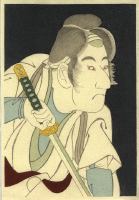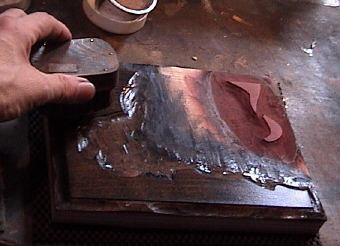Mica background on Sharaku prints
Mica Backgrounds
Perhaps the most well-known example of the use of mica powder on traditional Japanese prints is in the background of prints by Utamaro and Sharaku, published by Tsutaya Juzaburo in the last decade of the 18th century. I recently made a reproduction of a Sharaku design, and that provided an opportunity to take some photographs along the way ...
Before applying the mica powder to the background, a solid colour is printed. Here is an image of the print just after a bluish-grey background has been printed:

The mica printing follows immediately (the paper is still being maintained at the normal level of moisture for printing). Here are two photos showing the tools needed for the job. Inside the moistened newspaper on my left are the prints waiting to be done. A normal printing brush waits on its tile; in the small round cup is a splash of liquid glue (cut about 50-50 with water); the container of mica powder is visible, and next to it is the upturned lid of the container, with a small tea strainer sitting inside. Just below this is the waiting block - the same one used for the background colour printing.

In both photos, you can see the moistened newspaper pack directly in front of me which will receive the printed sheets. Off to the right is a shallow 'screen box' that I use for this mica printing; it is simply a cardboard tray with one of the screens from my windows laid on top of it.

Here's another view of the tray. A sheet of newspaper covers the bottom, and this will catch the brushed-off mica powder to be used again. A few pieces of tape are stuck to the screen; these will guide me in placing a mask over the print before I sprinkle on the mica.

Here's the first step - a swab of liquid glue onto the block:

Brush it out just as though it was a normal pigment mixture:

Lay the paper in place:

... and rub with the baren. Note that for this glue, it is important to use a lighter pressure than that used for typical colour printing. If the glue is driven right down into the paper, there will be nothing left on the surface to hold the mica.

Working quickly, lay the print face up on the screen, fitting it into the tape guides:

Place the mask on top; it fits into the 'L' guide on the left. This mask is made from a sample copy of the print glued down to a piece of card, and then trimmed to the appropriate shape.

Take the strainer, and lightly tap it while gently waving it over the area to be covered.

Too low and the mica will be deposited in clumps ... too high and it will fly all over the room ...

Using a very soft brush, gently wipe the mica off the surface of the print.

Using too much pressure will scrape away too much mica ...

That's it! Hold it up to the light, and enjoy!

The print is then gently slipped into the waiting damp newsprint, ready to receive the next impression. In this case, there are two 'colours' left, a deep black for the hair, and a karazuri pattern on the kimono ...
Photos by Himi Bull ...